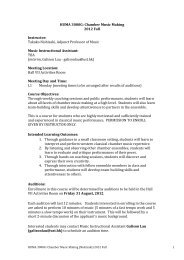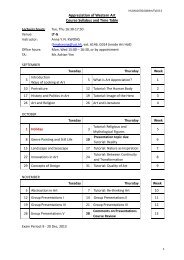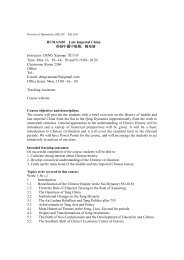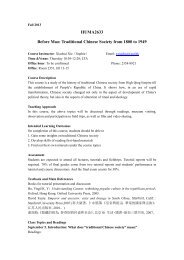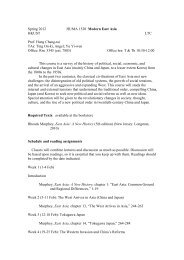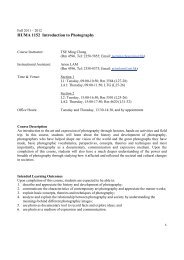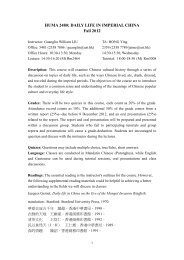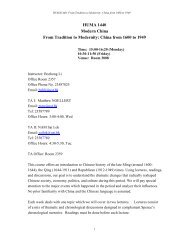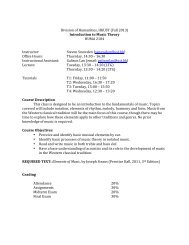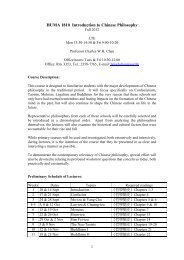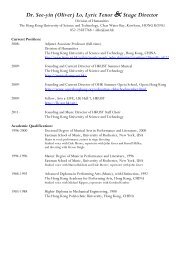TENTATIVE - Division of Humanities
TENTATIVE - Division of Humanities
TENTATIVE - Division of Humanities
Create successful ePaper yourself
Turn your PDF publications into a flip-book with our unique Google optimized e-Paper software.
<strong>TENTATIVE</strong>HUMA 2470 City and Village: Life and Culture in Modern China(student copy)Fall 2012, <strong>Division</strong> <strong>of</strong> <strong>Humanities</strong>, HKUSTInstructor: Dr. V. K. Y. HoOffice: Rm. 3347Email: HMVIHOKYOffice Hours: Wednesday and Friday 1530 to 1700, or by appointmentThis course surveys the social and cultural transformation <strong>of</strong> China, focusing on whathappened in major cities and rural communities, during the late-Qing and Republicanperiods, circa 1840 to 1940. The process <strong>of</strong> modernization, as well as the persistence <strong>of</strong>tradition, will be studied to redress some <strong>of</strong> the stereotype images <strong>of</strong> Chinese society andculture, both rural and urban. Social conditions and cultural phenomena in Chinese citiesand villages in this period are critically analyzed. Topics include analysis <strong>of</strong> Chinese cityplans and their social/political/cultural meanings, development and limitation <strong>of</strong> civilsociety in traditional/modern Chinese cities, the role <strong>of</strong> Western imperialism in urbandevelopment, the impact <strong>of</strong> warlords and the Nationalist on modernization in cities, theconditions <strong>of</strong> life in Chinese countryside, and the reality <strong>of</strong> political turmoil in Chinesevillages, etc..TextsNo textbooks are required. Prepared copies <strong>of</strong> articles and extracts from books andjournals are used instead. In addition, you are strongly encouraged to consultsupplementary reading materials (a list <strong>of</strong> them will be distributed) which are relevant tothis course, and hence are very useful in developing your interests and broadening yourknowledge on the topics discussed in this course, as well as in enhancing yourperformance in classroom discussion and examination.GradingGrade is based on your performance in classroom/tutorial discussions/attendance (10%),assignment(s) (30%) and examination (60%).Class Schedule and Reading AssignmentsLectures are delivered twice/thrice a week, depending on the final arrangement <strong>of</strong> tutorialsessions. Readings must be kept up with because they will help you to understand theselected topics in greater details.
Week 1: China’s City Plans: Continuity and ChangeReadings: Linda Cooke Johnson, Shanghai , chapters 3 & 4; 徐 泓 , "The Planning, PlanLayout and Symbolism <strong>of</strong> the Imperial Palace Compound <strong>of</strong> Nanjing in the Early MingDynasty" (in Chinese); 謝 敏 聰 ,’ 宇 宙 中 心 的 象 徵 ’,’ 中 國 的 都 市 觀 景 與 其 設 計 的 意境 ’,’ 總 結 ’。QFD: How was the imperial power ( 皇 權 ) manifested in major cities’ plans? What kinds<strong>of</strong> symbols were employed to highlight the imperial power? Were all traditional citiesbuilt strictly according to cosmological principles and imperial ideology? What were thepurposes <strong>of</strong> these architectural symbolisms in city plan?Weeks 2-3: Culture <strong>of</strong> Cities in Imperial ChinaReadings: F.W. Mote, "The City in Traditional Chinese Civilization"; Etienne Balazs.Chinese Civilization and Bureaucracy, pp.66-78; Rhoads Murphy, "City as a Mirror <strong>of</strong>Society: China, Tradition and Transformation"; William T. Rowe’s Hankow: Commerceand Society in a Chinese City, pp.1-16;Optional Reading: 東 京 夢 華 錄 .QFD: What could we learn about China’s society and cultures from studying history <strong>of</strong>her cities? Could we say that traditional Chinese cities were culturally and sociallyunique in comparison with her villages? Was Chinese city in traditional Chinesecivilization culturally insignificant as Balazs and Murphey claim?Weeks 4-5: Treaty Port Cities1) General: ‘ 前 言 '; ' 近 代 中 國 的 商 埠 'Optional reading: Rhoads Murphy’s “The treaty ports and China’s modernization” inElvin and Skinner eds., Chinese Cities Between Two Worlds.2) ShanghaiReadings: 吳 圳 義 . ' 清 末 上 海 租 界 社 會 ' chapters 2 & 4; 蔣 介 石 , ' 中 国 之 命 運 ', pp. 122-8, 130-6; 周 谷 城 , ' 都 市 社 會 里 的 人 ', pp.345-366;Optional reading: Mark Elvin, “The Administration <strong>of</strong> Shanghai”.
3) CantonReadings: 廣 州 港 史 ( 近 代 ), chapters 2 & 4; ‘ 廣 州 沙 面 租 界 概 况 'Optional reading: 廣 州 的 洋 行 與 租 界 , pp. 1-60; Ezra Vogel’s Canton UnderCommunism, chapter 1; V.K.Y. Ho, Understanding Canton, chapter 3.Week 6: Warlord CitiesReadings: 廣 州 港 史 ( 近 代 ), chapter 5; Kristin Stapleton, “Yang Sen in Chengdu”, inJoseph Esherick ed., Remaking the Chinese City; 張 靜 如 , 北 洋 軍 閥 統 治 時 期 中 国 社 會之 變 遷 , pp. 76-90, 287-304.Optional reading: Robert Kapp, "Chungking as a Center <strong>of</strong> Warlord Power, 1926-1937"Weeks 7-8: Nationalist Cities: 1928-1937Readings: Canton: 廣 州 港 史 ( 近 代 ), chapter 7; 南 天 歲 月 , pp.210-275, 331-363; ZwigLipkin, Useless to the State, chapter 1 “A New Society for the New Capital”.Optional readings: Christian Henriot’s Shanghai, chapters 5,6,8,9; Min-ch'ien, Tau. TwoYears in Nationalist China, chapter 10; 阿 勵 ed., 上 海 的 故 事 (Hong Kong: 1972), vols.1 & 2Week 9: Impressions <strong>of</strong> Life in Chinese CountrysideReadings: 周 谷 城 , ' 農 村 中 貧 富 懸 殊 之 風 險 ', pp.324-44; Jack and Sulamith Potters,China’s Peasants, chapter 1; William Hinton, Fanshen, chapters 1 to 4; Jean Chesneaux,China From the 1911 Revolution to Liberation, pp.111-116, 192-194.Weeks 10-11: Rural Society from a Different AngleReadings: Fei Hsiao-tung, Peasant Life in China, ( 中 譯 本 : 江 村 經 濟 )Chapters 3-7, 10-12, 15; 林 耀 華 , 金 翼 , chapters 1-7; Sidney Gamble, Ting Hsien, chapters 3, 5, 10, 13;Optional readings: 費 孝 通 , 鄉 土 中 國 , chapters 1,4,5,6; ‘ 廣 東 區 委 關 於 廣 東 農 民 運 動 報告 ', 廣 民 革 命 历 史 文 件 彙 集 vol.6; Hugh Baker's "The Lineage and the Clan"; Aijmerand Ho, Cantonese Society in a Time <strong>of</strong> Change, chapter 2.
Weeks 12-13: Rural RevolutionsReadings: Jack and Sulamith Potters, China’s Peasants, chapter 2; Jack Belden, “StoneWall Village”; 毛 澤 東 , ‘ 湖 南 農 民 運 動 考 察 報 告 '; 王 桧 林 , 中 國 現 代 史 , pp.182-191;C.K. Yang, A Chinese Village in Early Communist Transition, chapters 3-10.Week 14: Concluding Remarks



